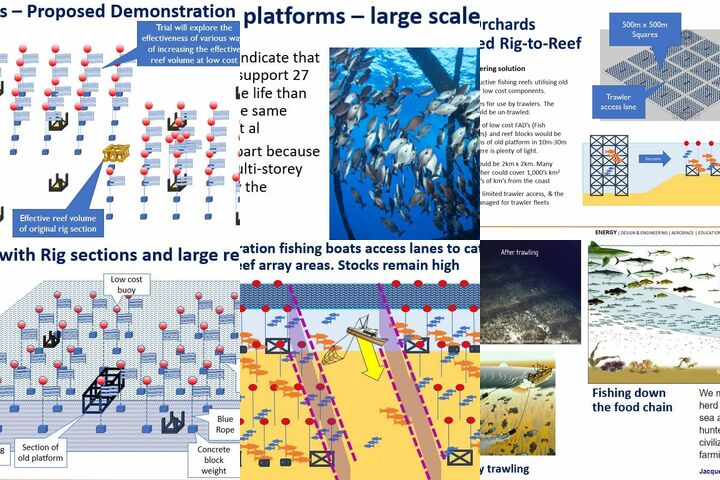OCEAN ORCHARDS - UPDATE
The Problem
The Decimation of Fish Stocks Around the World Industrial-scale fishing around the world is mostly done by trawlers. This has led to widespread destruction of crucial seabed habitat, which in turn has caused a collapse in fish populations. There is an urgent need to adapt the current practices to allow fish habitat on the seabed to be re-established, while still catching commercial quantities of fish. After extensive trawling, catches drop to 6% of the pre-trawling level. If numerous patches of seabed could be restored, habitats would recover and fish populations and catches will rebound to their natural high levels. Currently, 58% of global fish stocks have either collapsed or are over-exploited and on their way to collapse, while another 33% are at maximum capacity (Pitcher and Cheung 2013). Continued human population growth will lead to an even greater demand for fish and it is clear based on current data that existing fishing practices will be unable to meet future demand. A healthy ecosystem is essential for a productive fishery. Without the benthic habitat to provide essential ecosystem services, the food and shelter upon which the fish stocks rely will be absent, and in turn, the fish themselves will disappear. As larger fish disappear, fishing focusses on smaller fish, resulting in ‘fishing down the food chain’.
Our Proposal
What can be done? • Generate huge quantities of fish economically and profitably in new, specially built, habitat. How? • With a massive scale engineering project to build extensive areas of artificial reefs to form excellent fish habitats. • Build these new fishing reefs to be compatible with the existing trawler fleets. The Ocean Orchard artificial reefs will be away from the coast in areas of degraded seabed and will generate new populations of fish that can be caught by conventional trawler fleets. Initial estimates indicate that the annual revenue generated by the man-made reefs will be higher than the installation costs of the FAD arrays. The new Ocean Orchard artificial reefs will relieve pressure on existing fish stocks, provide spawning and juvenile fish recruitment areas which aid in rebuilding fish populations. This will secure and eventually expand the catch of fish in Malaysian waters. This additional catch of millions of tonnes of new fish could ultimately be worth billions of dollars per year in Malaysia alone, and tens of billions of dollars per year if applied around the ASEAN region. Artificial reefs have been used for many years, but not quite in this way. The combination of old platforms with massive new FAD arrays together generate massive quantities of fish profitably and sustainably in areas of the ocean that would have been otherwise practically barren. - Additionally each km2 of Ocean Orchard would collect significant BLUE CARBON.
We Assume that...
The existing rigs to reefs site at Pulau Kapas can be extended to demonstrate the Ocean Orchards principle
Fixed Fish Aggregating devices attached to concrete blocks or other structures will be sufficiently like oil platforms to be attractive habitat for fish.
Constraints to Overcome
We have been working with Malaysian authorities, companies, NGOs and Universities to build a body of support for this project. There is considerable interest in the project, but an understandable reluctance to finance a trial of an idea that has not been demonstrated at scale before. If the principle can be demonstrated, and works, it could well be adopted as part of all oil and gas decommissioning projects in Malaysia and eventually across the region The Ocean Orchards project needs a small amount of seed money, preferably from a recognisable international funder, to encourage others organisations to participate. In the long term, it is intended that the Ocean Orchards industry will be fully self-funded, profitable and producing millions of tonnes of new sustainably harvested fish.
Current Work
Attach fixed fish aggregating devices to Pulau Kapas site Proposed Timescales Short term – Next Year Install additional blocks and Fish Aggregating Devices on Pulau Kapas Monitoring program to assess effectiveness of extension options Medium Term – Next 2 Years For the next three decommissioning projects, assess, design and implement a series of Ocean Orchard demonstration sites Initial Ocean Orchards will be installed without trawler lanes, 5 miles from the coast Long Term – 2 to 10+ Years Optimise the Ocean Orchard design to maximise impact for minimum cost Install 100’s of square km’s of Ocean Orchard between 10-30m depth Establish the use of trawler lanes in specific designated areas Establish long term cooperation arrangement between the DoF, Petronas and the other interested parties.
Current Needs
This project is a 'lasting cure' solution which would help reverse the collapse of the fisheries (and coral reefs) if deployed at sufficient scale If this project is selected as one the 20, the funds will be used to assist with surveys of the existing rigs to reefs site If the project is selected for larger funding, they will be used to add vertical structure to the existing site We have been working with Malaysian authorities, companies, NGOs and Universities to build a body of support for this project. This needs to continue. There is considerable interest in the project, but an understandable reluctance to finance a trial of an idea that has not been demonstrated at scale before. If the principle can be demonstrated, and works, it could well be adopted across the region The Ocean Orchards project needs a small amount of seed money, preferably from a recognisable international funder, to encourage others organisations to participate.
